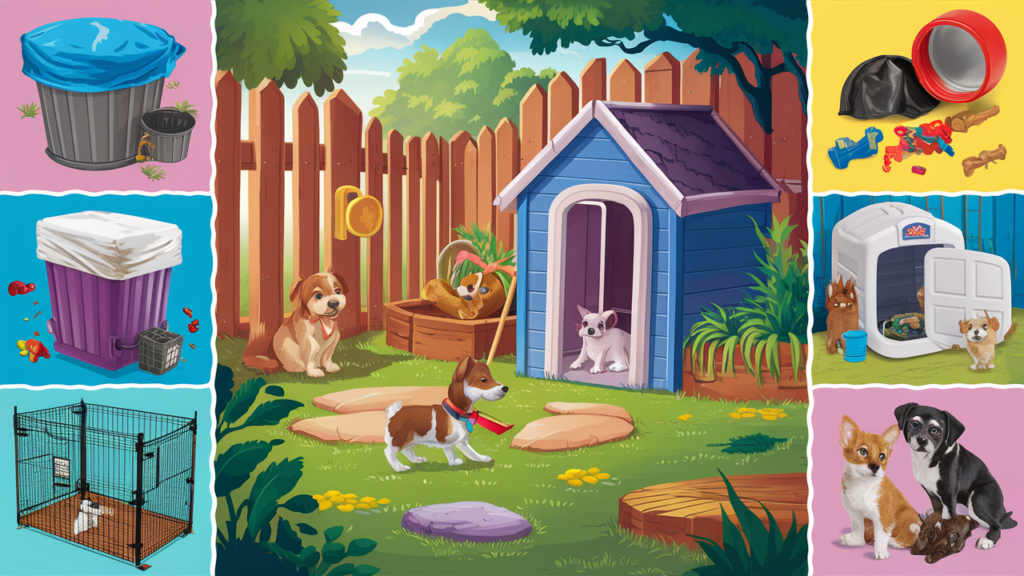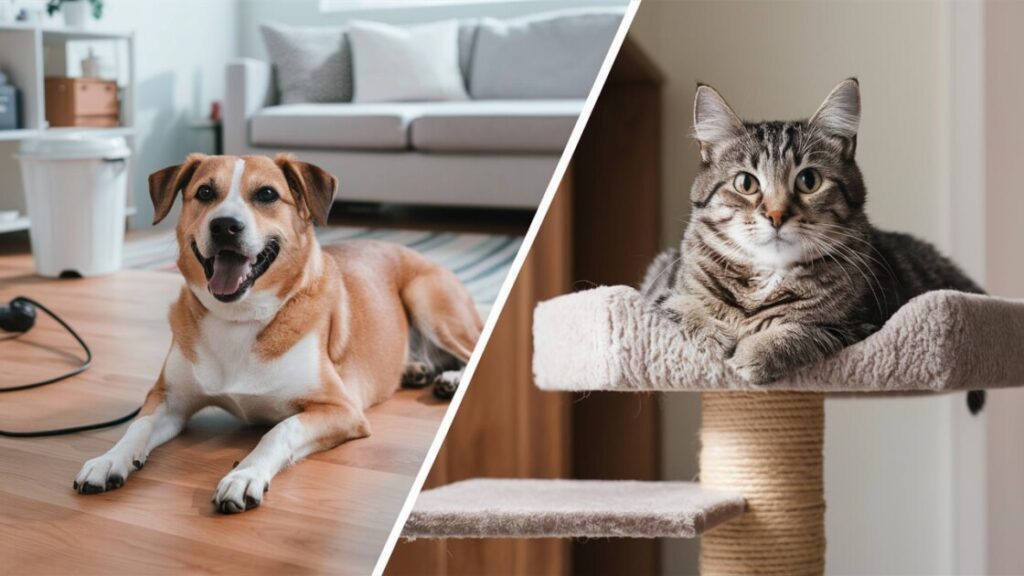Our furry companions bring immense joy into our lives, but with their playful antics and curious natures, they can sometimes get themselves into trouble. As a fellow pet lover, I understand the importance of creating a safe and secure environment for our cherished animals.

This comprehensive guide dives into essential home safety tips for pet owners, ensuring your home is a haven for both you and your four-legged friend. From common household hazards to preventing escapes, we’ll cover everything you need to know to keep your pet safe and sound.
Creating a Pet-Proofed Paradise: Room by Room Safety Measures
Let’s embark on a room-by-room exploration, identifying potential hazards and implementing practical safety solutions:
Living Room:
- Electrical Cords: Curious pets love to chew, and electrical cords pose a serious electrocution risk. Invest in cable organizers or cord covers to keep wires out of reach.
- Houseplants: Many common houseplants are toxic to pets. Research your plants beforehand and relocate any harmful ones to a pet-free zone.
- Toys and Throw Pillows: Small objects can be choking hazards for pets. Ensure toys are appropriate for your pet’s size and age. Put away throw pillows or any other small items your pet might try to swallow when you’re not around.
- Cleaning Products: Store all cleaning supplies, medications, and other chemicals in secure cabinets or shelves that your pet can’t access.
- Sharp Objects: Keep sharp objects like scissors, knives, and sewing needles safely tucked away in drawers or cabinets.
Kitchen:
- Food Hazards: Many human foods are toxic to pets. Keep food items like grapes, chocolate, onions, and xylitol (artificial sweetener) out of reach. Secure trash cans with lids that your pet can’t open.
- Hot Surfaces: Stovetops and ovens can cause serious burns. Keep your pet away from the kitchen while cooking and ensure they don’t jump on counters where hot pots and pans might be placed.
Bathroom:
- Toilet Bowl: Leaving the toilet lid open can be a drowning hazard for small pets. Invest in a toilet seat lock to prevent accidental falls.
- Medication: Store medications and personal care products in locked cabinets.
- Cleaning Supplies: Similar to the living room, keep all cleaning supplies and toiletries out of your pet’s reach.
Bedroom:
- Open Windows and Doors: Screen windows and balconies to prevent escapes, especially for adventurous felines.
- Laundry Hampers: Loose clothing and socks can be tempting chew toys for pets. Secure your hamper lid or keep it in a closed closet.
Garage and Basement:
- Toxic Substances: Antifreeze, pesticides, and other chemicals commonly found in garages and basements pose a serious poisoning risk. Keep these products locked away in cabinets or on high shelves.
- Tools and Equipment: Sharp tools and equipment should be stored securely to avoid accidental injuries.
General Safety Measures:
- Fire Safety: Develop a fire escape plan and practice it regularly with your entire household, including your pet. Consider a pet fire escape mask for emergencies.
- Identification Tags and Microchips: Ensure your pet wears a collar with identification tags, including your name, phone number, and emergency contact information. Consider microchipping your pet for additional identification security.
Beyond the Rooms: Additional Pet-proofing Pointers
- Poisonous Plants: Educate yourself about common plants that are toxic to pets. Here are some resources to help:
- The ASPCA Animal Poison Control Center: https://www.aspca.org/pet-care/animal-poison-control
- The Pet Poison Helpline: https://www.petpoisonhelpline.com/
- Chew Toys: Provide your pet with plenty of safe and stimulating chew toys to redirect their chewing instincts away from furniture or other household items.
- Blocked Vents and Openings: Cover any vents, drainpipes, or small openings where your pet might get stuck.
Preventing Escapes: Keeping Your Adventurous Pet Safe
Escapes can be extremely stressful for both you and your pet. Here’s how to minimize the risk:
- Secure Fencing: Ensure your fence is in good condition, with no loose boards or gaps that your pet could squeeze through. Consider adding a fence topper to deter adventurous climbers.
- Supervised Outdoor Time: Always supervise your pet when they’re outdoors. Leash them during walks and provide a secure outdoor enclosure if you allow them to spend time in the yard unsupervised.
Addressing Specific Pet Needs: Tailored Safety Strategies
While these general tips provide a solid foundation, remember to consider your pet’s specific needs:
Dogs:
- Separation Anxiety: Some dogs suffer from separation anxiety, making them more likely to chew or try to escape when left alone. Crate training or providing calming aids can help manage this anxiety.
- Destructive Chewing: Destructive chewing can be a sign of boredom or anxiety. Ensure your dog has plenty of stimulating activities and chew toys when left alone.
Cats:
- Climbing Instincts: Cats are natural climbers. Provide them with scratching posts and cat trees to direct their climbing energy away from furniture.
- Hidden Hazards: Cats are curious creatures and love to explore small spaces. Be mindful of potential dangers like open washing machines or dryers, and keep cabinet doors closed.
Small Pets (Rabbits, Guinea Pigs, etc.):
- Enclosures: Provide a safe and secure enclosure for your small pet.
- Electrical Cords: These pose a particular threat to small pets as they can easily chew through them. Double-check for exposed wires in their living area.
- Choking Hazards: Be mindful of small objects like beads or buttons that your small pet might try to swallow.
Building a Culture of Safety: Habits for Happy Pets
Creating a safe environment goes beyond just securing your home. Here are some habits to cultivate a safety-first approach:

- Routine Veterinary Care: Regular vet checkups ensure your pet stays healthy and help detect any potential health issues that could impact their behavior or safety.
- Pet-Safe Products: Choose pet-safe cleaning products and avoid using harsh chemicals around your pet.
- Be Aware of Toxic Foods: Educate yourself about foods that are toxic to pets and avoid leaving them within reach.
- Supervise Interactions with Other Pets or Children: Always supervise interactions between your pet and young children or other pets to avoid any accidental injuries.
Conclusion: A Safe Haven for Your Furry Family
By implementing these home safety tips and fostering a safety-conscious mindset, you can create a haven for your furry companion. A pet-proofed home filled with love, care, and a healthy dose of vigilance provides the perfect foundation for a happy and fulfilling life for both you and your cherished pet.
Remember, a little planning and proactive measures go a long way in ensuring your pet’s safety. Now go forth, create a safe and secure environment for your furry friend, and enjoy countless happy memories together!
Read Also –
Understanding Pet Behavior: Insights, Solutions, and Training Methods
Celebrating the Unconditional Love: A Guide to National Pet Parent Day 2024
FAQ: Furry Fun Without Fear – Essential Home Safety Tips for Pet Owners
1. My pet likes to chew on everything! How can I prevent destructive behavior?
Provide your pet with plenty of safe and stimulating chew toys to redirect their chewing instincts. Rotate toys regularly to keep them interesting, and consider puzzle feeders or treat-dispensing toys to challenge their minds and reduce boredom.
2. What are some signs of separation anxiety in pets?
Excessive barking, whining, chewing, destructive behavior, and pacing are all potential signs of separation anxiety. If you suspect your pet suffers from this, consult your veterinarian or a certified animal behaviorist for guidance.
3. My cat loves to climb the curtains. What can I do?
Cats have a natural climbing instinct. Invest in scratching posts and cat trees that cater to their climbing desires. Place them strategically near areas your cat gravitates towards, like windows or furniture they try to climb.
4. What are some essential items for creating a safe pet haven?
This depends on your pet’s species and needs. Here are some general essentials:
Safe and secure enclosure (for small pets)
Comfortable bedding
Food and water bowls
Safe chew toys
Collar and ID tag (for dogs and cats)
Scratching post or cat tree (for cats)
Leash (for dogs)
5. How can I make sure my yard is safe for my pet?
Ensure your fence is in good condition and secure, with no gaps or loose boards.
Consider adding a fence topper to deter adventurous climbers, especially for cats.
Remove any toxic plants from your yard.
Provide shade and shelter from the elements.
Supervise your pet when they’re outdoors.
6. What are some resources for learning more about pet safety?
The American Society for the Prevention of Cruelty to Animals (ASPCA): https://www.aspca.org/
The American Kennel Club (AKC): https://images.akc.org/governmentrelations/documents/pdf/Safe_Housing.pdf
The Humane Society of the United States: https://www.humanesociety.org/